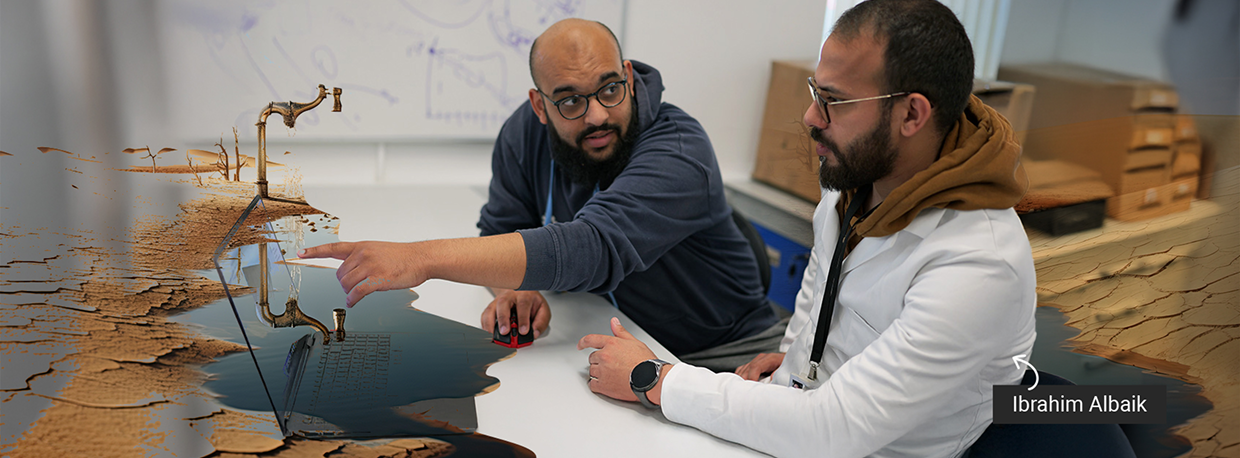


My journey began in Gaza, where I worked with one of the region’s largest companies specializing in central water infrastructure—including desalination plants, pump stations, and wastewater treatment facilities. This experience was deeply formative. I witnessed firsthand how the scarcity of fresh water was not just a technical challenge but a daily struggle for entire communities. In my neighborhood, for instance, municipal water was only available a few hours every other day, making access to clean water a persistent hurdle.
Motivated by this reality, I set out to find a better solution. In 2018, I moved to the UK to pursue a master’s degree, focusing on alternative technologies for water desalination. My academic journey reached a turning point when I was awarded a PhD scholarship at the University of Birmingham, shortly after receiving the Ratcliffe Prize as the top postgraduate student in the Engineering School.
During my PhD, I began collaborating with Kamal Diab, a fellow researcher who shared my passion for sustainable water solutions. This partnership was the beginning of what would become NovNat Tech. Together, we envisioned a new approach—one that could extract clean water from the air itself using energy-efficient, scalable technology, especially for regions where water is scarce or inaccessible.
Water scarcity is one of the most pressing global challenges of our time. Although Earth is covered in water, only 1% is accessible for human use. With rising consumption and unsustainable extraction from natural water sources, the UN projects a 40% gap between freshwater supply and demand by 2030.
Traditional solutions like Reverse Osmosis (RO) desalination play a role but come with major limitations. RO plants generate chemical-laden brine that pollutes marine ecosystems. They are also geographically restricted to coastal areas, and transporting desalinated water inland requires costly infrastructure—up to $3 million per kilometer for pipelines, with tens of thousands in annual maintenance costs per kilometer. Clearly, the world needs a more accessible, energy-efficient, and environmentally friendly alternative.
THE ATMOSPHERE
One promising but underutilized source is the atmosphere, which contains six times more water than all the rivers and lakes combined. Yet, this vast resource remains largely untapped. Existing Atmospheric Water Harvesting (AWH) systems work by cooling air to its dew point, a method that is energy-intensive, inefficient in low humidity (below 60%), and limited to emergency or small-scale use. Despite its potential, AWH has never been successfully scaled for industrial use—until now.
In 2022, after completing my PhD, I co-founded NovNat Tech with Kamal and Abdulbari Belouafi, a mechanical engineer from Algeria who brings his commercial vision to turn the technology into a market-ready product. Coming from water-stressed regions ourselves, we were united by a clear mission: to develop a scalable and sustainable solution to the global water crisis.
Our technology operates using low-grade heat—from sunlight or industrial waste streams—to release the stored water and regenerate the MOFs for continuous reuse. Just 1 kilogram of our material can produce over 10 liters of water per day, with no need for electricity or cooling systems.
We are aiming to integrate this material into standalone AWH units that produce over 10,000 liters of clean water per day, offering a scalable and cost-effective solution for industries and water-stressed regions.
Among the industries most affected by water scarcity are data centers, which rely heavily on evaporative cooling and consume vast amounts of water. As global demand for digital infrastructure grows, the need for sustainable cooling solutions is becoming urgent.
Our AWH systems offer a transformative alternative—enabling on-site water generation for cooling, drastically reducing dependence on external water sources. This not only lowers the water footprint of data centers but also improves overall energy and resource efficiency.
The AWH market is projected to grow from $3 billion in 2023 to $6.1 billion by 2030, with a compound annual growth rate of 10.8%. Recognizing this potential, NovNat Tech is actively partnering with leading HVAC manufacturers that serve major cloud providers like Amazon, Google, and Microsoft.
These collaborations are helping to integrate our AWH technology into next-generation cooling systems for large-scale facilities—paving the way for a future where industries can become net water positive.
Over the past 12 months, NovNat Tech has made significant progress in funding, partnerships, and commercialization efforts, solidifying its position as a leader in MOF-based AWH technology. Our startup has secured funding from both the UK government and the EU to support our R&D efforts in bringing this technology to market.
At NovNat Tech, our vision is to become a leader in sustainable water solutions. While we may not be able to solve water scarcity globally, we are committed to supporting industries with high water consumption and access to low-grade waste heat. By enabling a circular water economy, our goal is to help these industries become net water positive—producing more water than they consume. The surplus can then be used in municipal water systems, contributing to a broader water offset model that benefits entire regions.
On a personal level, my vision—as Ibrahim—is to bring this transformative technology to the Middle East, where water scarcity remains a major challenge. Our solution is uniquely suited to the region’s harsh, arid conditions, offering a groundbreaking approach to achieving water sustainability.